Related Blogs
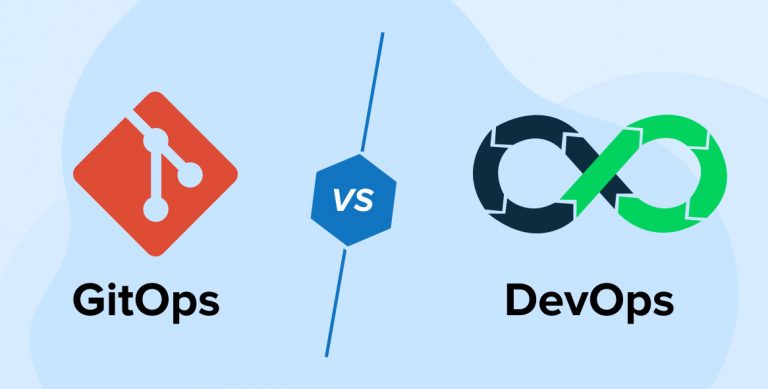
Nowadays, companies are embracing digital transformation, this means that they have started adopting modern technologies and cultures such as DevOps. It enables software development companies to produce new applications and services at a higher level. Besides, this culture also encourages shared responsibility, fast feedback, and transparency that helps in filling the gaps between different teams in the firm & speed up the process. Besides this, to increase the level of innovation, GitOps was launched in the market. It is a set of practices that enables developers to perform IT operations in a faster and more efficient manner. Basically, GitOps offers tools to take DevOps practices into consideration. To know more about these technologies, we will go through their definitions, history, and the differences between GitOps vs DevOps.
1. What is GitOps?
GitOps is an open-source control system that can be used to manage infrastructure automation, provisioning, deployment, and application configurations for any project or product. GitOps is a popular operational framework that developers use to utilize Git. With the help of GitOps, developers can be sure that Git is the key source that can be used for application source code, configuration and infrastructure management. The name GitOps means Git (the version control system) + operations (software development’s operations management aspect).
“In the DevOps world, #GitOps is perhaps unique in that it can potentially benefit both operations team members and developers.”
— 🦊 GitLab (@gitlab) October 10, 2019
Learn more from @TechBradD and @pritianka. https://t.co/Eg1VJl0Bf2
Besides this, Git is a technology that developers use to manage the deployment automation of the application. The Git repository enables retaining the entire state of the system while maintaining a detailed history of all the changes made by the developers in the system. Besides this, GitOps is a special framework designed to help developers perform management activities while they are using software development tools, processes, and techniques.
1.1 History
In the year 2017, Weaveworks focused on Kubernetes solutions and introduced the concept of ‘GitOps’. It was a set of best practices for application management and deployment by leveraging cloud services as an extension of the DevOps approach.
GitOps is a very useful, popular, and mission-critical tool for software development. It enables the developers to pull requests and code review workflows. Pull requests make the visibility of incoming changes clear to a codebase and also encourage discussion, communication, and review of changes. Pull requests are known as the pivotal feature of Git. They help developers collaborate on software development tasks and handle the changed way teams and businesses create a software solution. Besides this, pull requests have the capability to offer transparency and measurability to previous opaque processes. GitOps pull requests also enable the evolution of DevOps processes and because of all these things that GitOps started to offer, the system admins who were hesitant to make changes are now embracing this new practice of software development.
Before GitOps was launched in the market, the systems administration was managing the software development process manually by either connecting to the machine and provisioning IT infrastructure in a physical server rack or by provisioning it on the cloud. This process required large amounts of manual configuration and admins would have to keep custom collections of imperative scripts and configurations. But with GitOps coming into the picture, everything got automated. Now, collaborating on the tasks, infrastructure configuration, managing the app development process, and deploying the solutions can all be done easily with the GitOps workflow approach.
Besides this, when the GitOps idea was initially hatched and shared by WeaveWorks, the entire Kubernetes management firm has since proliferated throughout the DevOps community. The reason behind it is that GitOps has the capability to add some magic to the pull request workflow that synchronizes the live system to the static configuration repository.
“GitOps is game-changing for the industry. It is a replicable, automated, immutable construct where your change management, everything happens in Git.” – Nicolas Chaillan, Chief Software Officer of the U.S. Air Force
1.2 How Does GitOps Work?
IaC is handled the same as the app code in GitOps. This means that you use the same tools and processes as app code to manage configurations. You have to save these infrastructure configurations in the Git version and repositories. It gives you plenty of opportunity to test and review the changes before deploying them.
The GitOps workflow consists of a DevOps pipeline as well as a Git repository for the IaC project. To give you a general idea of how a GitOps workflow looks:
- Build a Git repository that can store both application code and IaC and can serve as the SSOT.
- Before you push back to the repository’s main branch, make changes or collaborate through the generation of pull/merge requests.
- Running a CI pipeline enables you to perform automated tests, validate configuration files, and integrate changes.
- Before applying the changes to the environment, ensure that they are tested thoroughly. You can review the changes and approve them if everything seems good.
- For the continuous deployment of your app infrastructure, you have to run a CD pipeline.
2. What is DevOps?
DevOps is one of the most popular practices that is a combination of cultural philosophies and tools used to increase any company’s ability to deliver software solutions and services at high velocity. DevOps benefits the software development lifecycle of any organization in a great way as it enables the development team to evolve and improve the products at a faster pace than before. This is done by modernizing the traditional development and infrastructure management processes. DevOps offers quick solutions which enable organizations to provide better service to their customers. Besides this, the development and operations teams of the firm can collaborate well, create solutions faster and launch them more effectively in the market.

2.1 History
The use of DevOps was started in the years 2007 and 2008. During this time, the IT operations and software development communities had raised concerns about this technology and its fatal effect on the industry. They wanted to stick up to the traditional software development model in which the code was written at the organizational level and the deployment & support were considered to be a part of the functional level. During those times, the developers and operation professionals had separate objectives, department leadership, and key performance indicators. As per these factors they were judged and different floors were allocated to them in the company’s building and because of all these things, the teams had to work for long hours. The separated work departments also caused issues in creating software which lead to unhappy customers.
But after DevOps came into the practice, the companies started to work on modern cloud infrastructure which centralized the entire app development process of the company. The developers started using agile methodologies for software planning and development after adopting DevOps. DevOps offers an approach that helps developers in managing modern cloud infrastructure, create and update code confidently without any issues, and have a unique transformation in the company’s system infrastructure modifications.
Basically, DevOps methodologies enable the development teams to work efficiently and offer the best results to their clients. Before going through the major differences between GitOps and DevOps, let’s have a look at some statistics. As per Statista, both DevOps and GitOps are the most important practices for open-source professionals in the year 2022 by 45%.
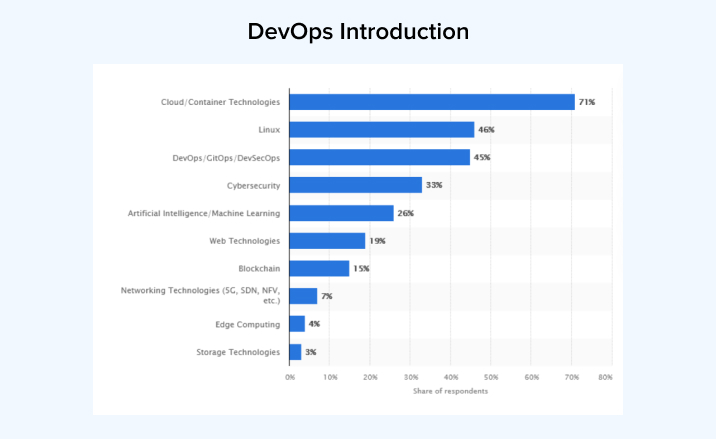
2.2 How Does DevOps Work?
When every stage of the software development lifecycle including development, testing, and deployment is seamlessly integrated to create a continuous process, it is known as DevOps. In addition to that, tools like CI/CD pipelines, version control systems, and automated testing frameworks are used to automate the entire process. The stages of a DevOps process are as mentioned below:
- Plan: In this stage, the development team gets clarity on the project requirements and objectives and comes up with an appropriate plan for how to move forward.
- Code: the development team uses Subversion, Mercurial, Git, and other version control tools for collaboration on the code.
- The development team works on the code using version control tools such as Git, Mercurial, and Subversion for collaboration.
- Build: After writing the code, it is compiled and prepared for deployment.
- Test: Running automated tests on the code to check if it works as per expectation or if it consists of any errors or bugs.
- Deploy: The frequent releases of the features into production or software deployment are carried out using a CD pipeline.
- Operate: This stage is about testing the software in a production environment. It helps the operation team to validate whether the software is the right fit for end users or not.
- Observe and monitor: Both development and operations teams continuously monitor the software and receive feedback. It enables them to find and fix the issues quickly.
3. Difference between GitOps and DevOps
Here are the major differences between GitOps vs DevOps –
Approach
GitOps: The main approach that GitOps uses is utilizing the Git tools that can manage software deployment and infrastructure provisioning.
DevOps: DevOps follows an approach that focuses on Continuous Integration/Continuous Delivery and isn’t tied to specific tools.
Focus
GitOps: The main focus of GitOps is on correctness which means doing DevOps correctly.
DevOps: The main focus of DevOps is on automation and frequent software changes and deployments.
Flexibility
GitOps: GitOps is a bit stricter and less open.
DevOps: DevOps is less strict and more open.
Main tool
GitOps: This technology uses all Git tools available in the market.
DevOps: This technology uses CI/CD pipeline.
Other tools
GitOps: Some tools that GitOps uses are Kubernetes, Infrastructure as Code, and separate CI/CD pipelines.
DevOps: Some tools that DevOps uses are cloud configuration as code and supply chain management.
Correctness
GitOps: GitOps is designed by keeping correctness in mind.
DevOps: DevOps is designed to maximize automation.
4. What are the Similarities Between GitOps and DevOps?
In addition to the differences, there are many similarities between the DevOps concepts and GitOps principles. Let us explore a few:
1. Both DevOps and GitOps are about improving the efficiency of SDLC.
The SDLC or software development life cycle is about building software from beginning to end. It includes everything from designing to deployment.
DevOps focuses on the importance of communication between teams and automating the operations to shorten the SDLC. Similarly, GitOps also presses on using code repositories such as GitHub that act as a single source of truth. It helps the teams stay clear of any sort of confusion and effectively manage the SDLC.
2. To improve communication and efficiency, both concepts advocate in favor of automation.
The primary goal of both these approaches has always been to automate the software development tasks to enhance efficiency. The number of errors is reduced when the process is automated.
3. Both DevOps and Git Ops aim to reduce errors and increase transparency.
Both approaches advocate for automation with the goal of reducing the errors in the process. They also try to avoid unexpected issues and surprises down the road by increasing transparency in the process as much as possible.
5. How Can GitOps Benefit You?
Any company can easily integrate GitOps with DevOps, and because Git is the standard tool for the software team, the majority of the developers are familiar with it which allows them to be a part of various processes that happen in the organization. GitOps is a process that allows any changes that are made in the firm’s system to be tracked and monitored. Besides this, with GitOps locating the source of the issues, creating a culture of transparency in system architecture is easy, and it also helps in complying with the security regulations. In addition to this, GitOps also offers continuous integration (CI) and continuous delivery (CD) on top of declarative infrastructure which helps developers not worry about scripting and start the deployment process quickly, says Kelsey Hightower a famous American software engineer who works on Kubernetes and cloud computing.
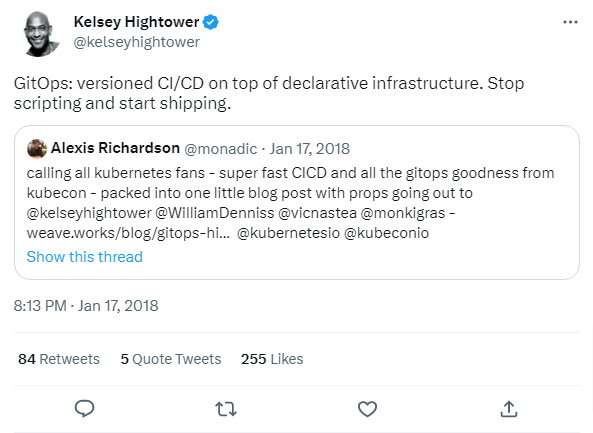
Basically, when any organization adopts GitOps, it can easily increase the team’s productivity by enabling the developers to experiment with new infrastructure configurations freely. This is possible because Git comes with a history of functions that enables the teams to revert changes that don’t help the system’s improvement. This is why GitOps is the best and most handy tool for developers who want to work with complex infrastructure in an easy way.
6. Benefits of DevOps Over GitOps
Using DevOps over GitOps in your software development lifecycle can provide you with certain benefits like:
6.1 Increased Productivity, Faster Delivery
In DevOps, the process is continuous from development to deployment. This helps increase the speed of the development process and improve productivity along the way. Moreover, the implementation of DevOps practices accelerates the testing process and makes it more efficient.
6.2 Renews Focus On Customers
One of the major reasons why DevOps is a preferred approach to software development is because it shifts the focus back to the customers. A common mistake developers tend to make while building software is that amidst all the development tasks, their focus slides off from the customer to the development side.
Software development is for the betterment of the customer. So, instead of developing for the sake of completing the task or building the product, DevOps practices help development teams focus on addressing the specific requirements of the customers.
6.3 Supports End-to-End Responsibility
Both development and operations are included in DevOps. It emphasizes the collaboration and support between teams to foster end-to-end responsibility-sharing for every task including specification gathering, programming, testing, validating, deployment, customer education, and feedback.
6.4 Stable Operating Environments
DevOps aims to provide a collaborative and supportive environment to both teams. With continuous integration and continuous testing in a shared codebase between the teams, if there are any problems in the code, configuration, or infrastructure, they can be found and fixed in the early stages.
You can handle the issues well when detected earlier in the process. This also lays the foundation for a stable and productive operating environment.
6.5 Cost Reduction
Strategic implementation of DevOps can save a lot of money for your business. Some of the costs that DevOps can help you save include:
1. Software Release Costs
You can automate the entire software deployment cycle using DevOps. Automation leads to reduced iterations and faster releases. You will need less workforce and your software deployment costs will be reduced drastically.
2. Network Downtime Costs
Chaos ensues during network downtime. It results in a loss of both money as well as customers. But DevOps offers CI/CD practices that make your code more efficient and fix bugs in real-time.
Moreover, you can constantly monitor the performance of your software application using its Application Performance Monitoring tools. It helps businesses reduce network downtime costs.
7. GitOps Use Cases
GitOps Use Case!#GitOps #GitHub #Git #DevOps #AIOps #DevSecOps #Kubernetes #Dockers #100DaysOfCode #code #CodeNewbie #Developers #OpenSource #Python #Java #tech #API #technology #Data #AWS #cloud #Hadoop #BigData #microservices #design #architecture #Engineering #AI #RT #bot pic.twitter.com/haaMQpLm2V
— 𝔸𝕞𝕚𝕥𝕒𝕧 𝔹𝕙𝕒𝕥𝕥𝕒𝕔𝕙𝕒𝕣𝕛𝕖𝕖 (@bamitav) November 20, 2021
Here are some of the major use cases of GitOps –
- Network slicing – GitOps helps the software development services providers to differentiate service tiers and users to pay only for the required bandwidth. This includes a premium subscription for any video streaming application and lower prices for IoT-based devices connected to it.
- Smart city services – When it comes to implementing the services related to the smart city, there are many challenges that the developers face like roll-out or managing complex platforms. In this case, GitOps can help in handling all the difficult systems and operations.
- Addressing network congestion – In big cities, users face network congestion issues while being connected to a 4G network. But with 5G coming into the market, this problem seems to have lessened still it requires cloud-native principles to manage various edge nodes. To solve this issue, network-providing companies use GitOps.
8. DevOps Use Cases
Here are some of the major use cases of DevOps –
- Online Financial Trading Company: DevOps methodologies can be useful in creating and testing applications in the financial trading company. The use of DevOps while deployment makes the process faster and the clients can get the product features implemented quicker.
- Car Manufacturing Industries: Car manufacturing industries use DevOps to help employees catch errors easily while scaling production.
- Early Defects Detection: Any type of organization can use DevOps to detect errors efficiently at the earliest stage possible.
9. Conclusion
As mentioned in this blog, GitOps has offered real value to many organizations by being a powerful tool that helps in managing system’s cloud infrastructure which offers a lot of benefits to the software service provider companies without blocking the developer out with too many tooling choices, and by increasing the productivity of a devops team. DevOps brings a cultural change in the way any company’s development or operational team works in a much collaborative way. Also both these technologies offer benefits like communication, stability, visibility, and system reliability. Adopting these approaches can be beneficial but which to use is dependent on type of operations the firm carries out.
FAQs
Is GitOps a subset of DevOps?
GitOps is optional. A DevOps team does not necessarily have to incorporate it. In comparison to DevOps, GitOps is a narrower practice whereas the scope of DevOps includes every aspect of SDLC.
What is the purpose of GitOps?
GitOps aims to automate the process of provisioning infrastructure. With GitOps, the operations teams use configuration files stored as the app source code. Whenever you deploy, the GitOps configuration files can create the same infrastructure environment as the app code creates the same app binaries.
How are GitOps and DevOps related?
DevOps practices provide an opportunity for teams to work collaboratively and more efficiently. GitOps, sharing the same objective, offers CI/CD and version control tools to automate infrastructure and app deployment.
What are the 7Cs in DevOps?
The 7 Cs in DevOps are continuous operations, continuous planning, continuous integration, continuous testing, continuous monitoring, continuous delivery, and continuous feedback.

Vishal Shah
Vishal Shah has an extensive understanding of multiple application development frameworks and holds an upper hand with newer trends in order to strive and thrive in the dynamic market. He has nurtured his managerial growth in both technical and business aspects and gives his expertise through his blog posts.
Related Service
Custom Software Development Services
Learn More about Custom Software Development Services
Know MoreSubscribe to our Newsletter
Signup for our newsletter and join 2700+ global business executives and technology experts to receive handpicked industry insights and latest news
Build your Team
Want to Hire Skilled Developers?


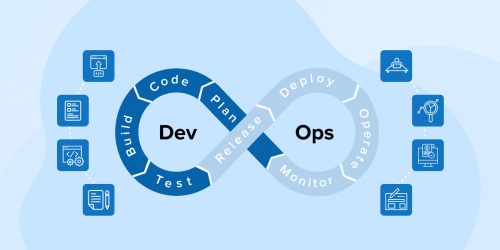
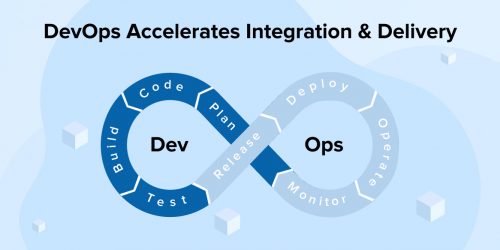

In this world of modern technologies having knowledge about GitOps and DevOps is very important. I really was not so aware of it. Thank you for sharing!